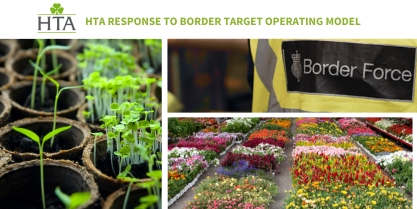Positive first steps, but the HTA urges further progress on Border Trade Plans for horticulture
The Horticultural Trades Association (HTA) has responded to the final publication of the Border Target Operating Model (BTOM), welcoming certain aspects of the model, such as commitments to digitise phytosanitary certificates and for the government to create a consultative business readiness group. However, it also expresses disappointment in other areas that could have critical implications for the horticultural sector and says that the BTOM is potentially a missed opportunity for UK horticulture.
 Fran Barnes, Chief Executive at the Horticultural Trades Association (HTA), said, “Our unwavering focus has consistently centred on ensuring the seamless, swift and secure movement of plants and plant products, whilst protecting the UK against biosecurity threats. While we acknowledge the positive strides made with the formal release of the Border Target Operating Model, the model doesn’t go far enough in adequately addressing the legitimate needs of the horticultural sector.
Fran Barnes, Chief Executive at the Horticultural Trades Association (HTA), said, “Our unwavering focus has consistently centred on ensuring the seamless, swift and secure movement of plants and plant products, whilst protecting the UK against biosecurity threats. While we acknowledge the positive strides made with the formal release of the Border Target Operating Model, the model doesn’t go far enough in adequately addressing the legitimate needs of the horticultural sector.
“One major concern lies in the readiness of Border Control Posts (BCPs) to handle the diverse range of imports received by the horticultural sector from the EU. We welcome the proposed delay to the introduction of checks at BCPs until 30 April 2024. However, we are disappointed that this date is inconveniently placed in the middle of the high season for the plant trade and that the delay is not long enough to complete the proposed pilot of the Authorised Operator Status model.
“Since January 2021, the industry has followed import and export requirements outlined in the Trade & Co-operation Agreement (TCA) due to the absence of a Sanitary Phytosanitary (SPS) or plant health agreement with the EU. However, it is clear there needs to be better dialogue between the EU and the UK regarding plant imports. Given that the value of imported plant material surpassed £753 million in 2022, constituting half of the cumulative value of the UK's trees, plants, seeds, and bulbs production sector, it is imperative that we impress upon the government the need for ongoing refinement of the BTOM.
“Furthermore, this issue will impact garden centre customers: the expected costs of full border controls to the supply chain are estimated to top £42m per annum (at existing pre-notified consignment numbers). Therefore, beyond 2024, this would equate to a 4.5% cost increase for no material gain. And there is also potential that plant ranges will be restricted or delayed, meaning a reduced choice for garden enthusiasts.”
The HTA emphasises the importance of meticulous planning, thorough testing, and effective communication to ensure a smooth transition to any new trade system, recognising the significance of the horticulture industry.
The following concerns still need to be addressed:
- Systems, processes and equipment must be thoroughly tested, preferably using a soft launch approach. The seamless integration of technology is key to a successful border, and clear timelines on business-critical upgrades to current systems, such as IPAFFS, e-phyto and CITES, need to be set out with some urgency.
- Control Points as an alternative to BCPs for businesses. While the 3-month delay gives more time for businesses to complete Control Point designation, the government should allocate sufficient resources to assist businesses through the process in a timely and cost-effective manner. There is also still no surety of costs, and the ability to compare BCP costs with CP costs is still not evident.
- The detail of the Authorised Operator Model status (AOS) and its accessibility for horticulture businesses – The HTA continue to be concerned about the AOS model, its pilot and subsequent launch. The proposed timings do not afford a seamless transition for businesses from the point of designation system to Control Points status and achieving AOS. The process for attaining AOS is still unclear, with costs and processes unpublished.
The HTA, representing over 1,500 members across the UK environmental horticulture sector, plays a crucial role in the industry. The association is committed to working collaboratively with the Government to ensure that the plant trade remains a top priority.
Sally Cullimore, Technical Policy Manager at the Horticultural Trades Association, added:
"We want to work with the Government to deliver a border model that is efficient, cost-effective, accessible to all businesses and recognises the EU's unique role in supplying the UK gardening and landscape market. The horticultural sector faces an unprecedented regulatory burden, and we need the Government to understand our industry's importance and impact. While we welcome some changes in this final publication, we are disappointed that the final model has not fully addressed our red line asks. We urge the government to keep the door open on the BTOM to enable us to continue to collaboratively engage with Defra and other stakeholders in our shared pursuit of enhancements that will notably benefit UK horticulture.”
Further Information:
The link to the BTOM is here: The Border Target Operating Model: August 2023 - GOV.UK
Defra has published further detail on the plant health proposals on the Plant Health Portal
Defra will be hosting an online session for horticulture on 7 September: BTOM: What does this mean for the horticultural sector? | Eventbrite
There will also be an online session on 21 September for traders who move goods between Great Britain (GB) and Ireland: BTOM: What does this mean for exports from Ireland?
